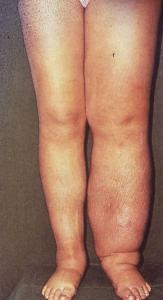Lymphedema of the arm
Effective Self-Care Guide for Lymphedema and Lipedema
— Joachim Zuther, Lymphedema Specialist
GRANT-VALKARIA, FL, UNITED STATES, December 13, 2023 /EINPresswire.com/ — When a portion of the lymphatic system is injured by trauma, surgery or radiation, or develops abnormally, the functionality of the lymphatic system is impaired. In many cases this can cause swelling, which most often affects the upper or lower extremities.
A well-balanced exercise program in combination with other treatment options used in the management for lymphedema is an important component to reduce the swelling, and a vital tool for patients to continue with normal activities of daily living.
Patients affected by Lymphedema can effectively self-manage this condition with self-MLD (Manual Lymph Drainage), proper skin care, exercises and compression.
In the book “It’s Not Just a Swelling! – Lymphedema”, which is geared toward the patient, their family members and caregivers, all aspects of proper and effective management of Lymphedema and related conditions are covered. Included are detailed descriptions of treatment techniques used by certified lymphedema therapists, as well as other important techniques of self-management, such as the use of compression pumps and garments, and exercises.
The book is available on Amazon as paperback, hardcover and e-book. The book is also available on Lulu.
Exercise protocols are customized by the lymphedema therapist and physician to meet individual goals for patients affected by lymphedema. The specific exercise protocols are determined by considering the stage and type of lymphedema, specific restrictions and limitations of joint and muscle activity, as well as additional medical conditions.
Decongestive Exercises
Active, non-resistive and repetitive exercises are an important part in the treatment of lymphedema. Unlike the heart in the blood circulatory system, the lymphatic system does not have an active pump to propel lymphatic fluid back to the bloodstream. Effective lymph flow depends on sufficient muscle and joint activity, especially if the functionality of the lymphatic system is compromised. Decongestive exercises are most effective if performed with the patient wearing compression garments or bandages, which are also essential components in lymphedema management.
Abdominal Breathing Exercises
The downward and upward movement in diaphragmatic breathing is an important component for the sufficient return of lymphatic fluid back to the bloodstream. Patients affected by lymphedema of the leg benefit greatly from an exercise program including diaphragmatic breathing exercises. The movement of the diaphragm, combined with the outward and inward movements of the abdomen, rib cage, and lower back promotes general well-being, peristalsis and return of venous blood back to the heart.
Resistive Exercises
Exercises combined with resistance improve muscular power increase the strength in ligaments, tendons and bones. An additional benefit is their contribution to weight control. Resistive exercises are typically performed in a repetitive manner against an opposing load. Certain strength exercises are beneficial for lymphedema patients and should always be performed with the compression garment or bandage in place. Resistive exercises using inappropriate weights present a risk for injury or overuse and should be discussed with the treating therapist and physician.
Aerobic Exercises
Aerobic conditioning is generally performed in a repetitive fashion using large muscle groups. Some long-term benefits include decrease in resting heart rate, improved muscular strength, weight control and increased return of venous and lymphatic fluids. It is important to understand that certain aerobic exercises and recreational activities could trigger an increase in swelling and should be avoided by patients affected by lymphedema. Examples of these high-risk activities include soccer, kick-boxing or step-aerobics for lower extremity lymphedema, and tennis or golf for lymphedema affecting the arms. Beneficial activities include swimming, walking, water-aerobics, easy biking or yoga.
Aquatic Exercises
The buoyancy effect water has on the musculo-skeletal system makes movement more comfortable. Range of motion and flexibility are increased when in a warm water pool and the cardiovascular system is working more effectively, so an aerobic workout is possible. Additionally, the hydro static pressure acts like a “full-body garment” and helps to reduce swelling. Exercises in the water geared toward the treatment of lymphedema are resistive, assistive/supportive, compressive, relaxing and comforting.
Joachim Ernst Zuther
Lymphedema Blog
+1 772-913-1027
email us here
Visit us on social media:
Facebook
LinkedIn
Instagram
YouTube
Joachim Zuther, Lymphedema Specialist, talks about the Importance of the Treatment of Lymphedema
![]()
Originally published at https://www.einpresswire.com/article/674897176/lymphedema-self-care-the-role-of-various-exercise-modalities-in-the-treatment-of-lymphedema
The post Lymphedema Self-Care: The Role of Various Exercise Modalities in the Treatment of Lymphedema first appeared on Beauty Ring Magazine.
Beauty - Beauty Ring Magazine originally published at Beauty - Beauty Ring Magazine






